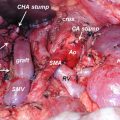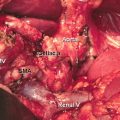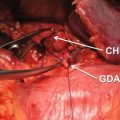Author
Lin
Seiler
Tran
Seiler
Year
1999
2000
2004
2005
Country
Taiwan
Switzerland
Netherlands
Switzerland
Operation (PD/PPPD)
15/16
49/37
83/87
66/64
Operation time (minutes)
PD
237
476
200
449
PPPD
215
404
300
382
Estimate blood loss (ml)
PD
687
2096
2000
1500
PPPD
451
1453
2000
1196
DGE
PD (%)
7
45
23
45
PPPD (%)
38
37
22
31
Pancreatic fistula
PD (%)
13
2
14
2
PPPD (%)
0
3
13
3
Mortality
PD (%)
0
5
7
3
PPPD (%)
7
2.7
3
2
Survival
PD
NA
16 ma
14 mb
ND
PPPD
24 ma
15 mb
In all of the RCTs, it was possible that underpowered trials had overestimated the results due to small scale studies, and it was concluded that large absolute differences in other key outcomes are unlikely; excluding relatively small differences will, however, require larger, stronger methodologies [15].
Diener reported the Cochrane Database systematic review. A total of 465 participants demonstrated vast heterogeneity with regard to the quality of the methodology and outcome parameters. The incidence of DGE showed no significant difference between PD and PPPD. Hospital mortality, morbidity, and overall survival also showed no significant differences. However, the operating time (95% CI −105.70 to −30.83; P value 0.0004) and intraoperative blood loss (95% CI −0.96 to −0.56; P value <0.00001) were significantly reduced in the PPPD group rather than PD group. All significant results are associated with low quality of evidence, and as determined on the basis of this, no evidence suggests relevant differences in mortality, morbidity, or survival between the two operations [16].
31.2 Pylorus-Resecting Pancreaticoduodenectomy (PRPD)
The gastrectomy site might affect the rate of occurrence of DGE and survival of cancer patients; however, there is no data on the gastrectomy site. At what distance is the gastrectomy performed from the pylorus ring? How much stomach is remnant? All of the four RCTs demonstrated that the incidence of DGE in PPPD was similar to that in PD [11–13]. If only extended gastrectomy patients were included in those studies, those RCTs might demonstrate other results. Kawai et al. reported the result of an RCT focused on the pylorus ring, PPPD versus pylorus-resecting PD (PRPD), with near total stomach preservation. They gave it the name of pylorus-resecting PD (PRPD) and proposed this as a new procedure [17]. It was determined that the incidence of DGE was 4.5% in PRPD and 17.2% in PPPD, with a significant difference. This RCT is an epoch to determine whether the pylorus ring affects the occurrence of DGE or not, and it revealed that the pylorus ring is the deciding factor in the occurrence of DGE.
31.3 Subtotal Stomach-Preserving Pancreaticoduodenectomy (SSPPD)
Japanese surgeons have previously performed SSPPD, which is PD combined with an intended antrectomy; however, SSPPD does not clearly define the gastrectomy site [18]. A meta-analysis demonstrated that the occurrence of DGE favors SSPPD compared to PPPD (odds ratio 2.75, 95% CI 1.75–4.30, P < 0.00001) [19]. However, PRPD was included in the SSPPD group in this meta-analysis. Distal gastrectomy in PD is associated with gastric emptying via gastroenteric hormones [20], and the RCT (PPPD vs. PRPD) has clarified the importance of the antrum [20]; therefore, the concept of PRPD is different from that of SSPPD.
31.4 Reconstruction Route of PPPD
Reconstruction route was previously thought to be important in the occurrence of DGE. Two reconstruction routes are usually considered for duodenojejunostomy, the antecolic route or the retrocolic route in PPPD. However, Tani et al. paid attention to the reconstruction, and an RCT was conducted to analyze whether or not an antecolic route reduces the incidence of DGE compared to a retrocolic route. DGE occurred in 5% of patients with the antecolic route for duodenojejunostomy versus 50% with the retrocolic route (P = 0.0014). Those with the antecolic route had a significantly shorter duration of postoperative nasogastric tube drainage than did those with the retrocolic route (4.2 days versus 18.9 days, respectively, P = 0.047). This result demonstrated the superiority of the antecolic route in prevention of DGE by interim analysis [21]. Therefore, this RCT investigated a small cohort of patients, although this RCT was statistically planned for 140 patients. Table 31.2 shows the summary of RCTs focused on only PPPD assigned into two groups: antecolic reconstruction and retrocolic reconstruction.
Table 31.2
Summary of four prospective RCTs to compare between antecolic reconstruction and retrocolic reconstruction in PPPD patients
Author | Tani | Tamandl | Imamura | Eshuis |
Year | 2006 | 2014 | 2014 | 2014 |
Country | Japan | Austria | Japan | Netherlands |
Operation (ante/retro) | 54/57 | 20/20 | 36/28 | 60/60 |
DGE | ||||
Antecolic (%) | 5* | 17 | 12 | 58 |
Retrocolic (%)
Stay updated, free articles. Join our Telegram channel
Full access? Get Clinical Tree
 Get Clinical Tree app for offline access
Get Clinical Tree app for offline access

| ||||



